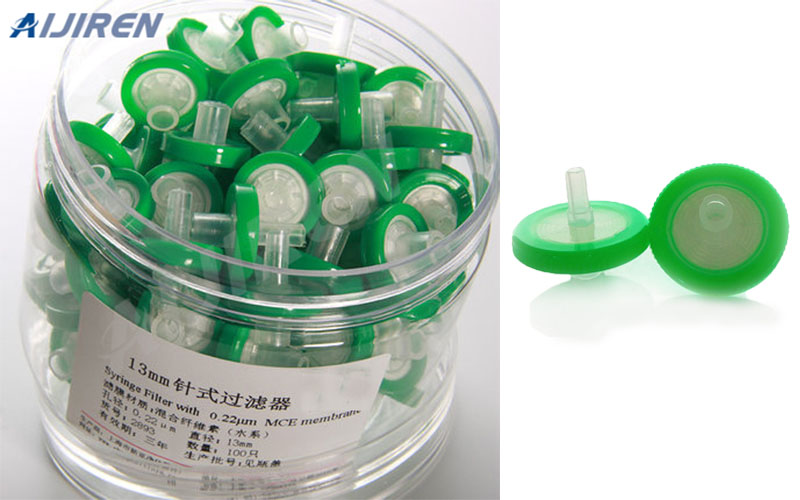Aijiren MCE Syringe Filter
In HPLC analysis, the particle size of the chromatographic column packing is small and it is easy to be blocked by impurity particles. Therefore, samples and solvents need to be filtered in advance to remove particulate contaminants and protect the instrument. Ion chromatography, which is commonly used in environmental analysis, also requires that no inorganic contaminants be introduced in sample pretreatment. Syringe filters can be used in HPLC analysis and IC analysis. Filtering sample solutions is an important step in the sample pretreatment process.
Syringe filter is the fastest and most effective method for filtering small samples. It does not require membrane replacement and filter cleaning, which saves complicated preparations and saves a lot of time. The needle filter has uniform pore size, no media shedding, thin texture, low resistance, fast filtration speed, and very little adsorption. It can be used to filter particles and bacteria of gases, oils, beverages, wine, etc., and can be used as a test for particles and bacteria.
The needle filter is flexible in usage and can precisely control the flow of liquid. The outer shell is made of polypropylene (PP) with excellent chemical stability and is made of different colors, which is convenient for users to distinguish products of different specifications and avoid confusion. The filter membrane adopts imported high-performance filter membrane with stable product quality and good reproducibility. It is an ideal choice for laboratory filtration of samples. The standard interface is convenient to connect to various syringes, and it can also be directly connected to the needle of the 7725 valve, and the sample can be injected directly after filtration.

Aijiren’s advantages:
Faster flow rate: Larger membrane surface area improves flow rate and throughput. It also reduces the pressure required to empty the syringe, making it easier to filter the solution.
Higher operating pressure: The maximum housing pressure of the filter is 10.5 bar (150 psig), which means you can filter solutions faster than before.
Application scope:
1.Sample preparation, purification and pretreatment of HPLC, MS, LCMS, GC, GCMS, IC and other instruments.
2. Preparation of biological products.
3. Filtration of tissue culture media, microbial media, buffer solutions and other liquid samples.
4. Purification and clarification of corrosive solutions.
5. Filtration of a small amount of sample to remove impurities and precipitation in the sample
Material: The outer shell is medical grade PP, and the inner filter membrane is a Mixed Cellulose Ester membrane, commonly known as water-based filter membrane and water-phase filter membrane.
Quality Assurance: This product adopts imported medical-grade production equipment and a class 100,000 clean workshop. Each filter is tested for air tightness, and each batch of products is tested for integrity, chromatographic analysis, and ultraviolet absorption comparison. Strive for a 100% pass rate.
Uses: Generally used to filter neutral or partial neutral aqueous solutions, can be used as experimental sample clarification filtration, liquid chromatography injection filtration, etc. Not suitable for filtering organic solvents and strong acid and alkali solutions. This filter is for one-time use, filtering about 10 ml at a time (specifically, there is a big difference according to the impurities of the filtered liquid), and the filter membrane cannot be disassembled. 0.45μm can remove conventional impurities and some bacteria visible to the naked eye. Generally used in conjunction with the syringe.
Sterilization method
1. Steam sterilization, 30 minutes.
2. Autoclave sterilization (125°C, 30 minutes).
3. Rinse in a 75% ethanol solution for a short time. This method has a certain impact on the material of the filter membrane and is not commonly used.
4. Ethylene oxide sterilization;

The difference between different material filters:
1. Water system is generally used to filter neutral and partial neutral aqueous solutions.
2. For organic systems, organic solutions are generally filtered, but some organic solutions are not applicable.
3. Polytetrafluoroethylene has the widest application range, which can filter aqueous solutions, organic solutions, acid and alkaline solutions.
For users who need to use a large pore filter (such as 0.8μm, 1.2μm), you can choose a replaceable membrane filter, and then a large pore filter with the corresponding diameter.
Various membrane characteristics:
Hybrid cellulose membrane is suitable for water-based solutions, the most commonly used filter membrane.
Polyethersulfone membrane (PES) is suitable for water-based solutions, has high chemical and thermal stability, fast flow rate, strong acid and alkali resistance (pH range 1-14); it has high mechanical strength.
Nylon membrane is suitable for organic solutions and aqueous solutions. It has good hydrophilicity, acid and alkali resistance, and antioxidant. It is not only suitable for aqueous solutions containing acid and alkali, but also suitable for organic solvents, such as alcohols, hydrocarbons, lipids, phenols, ketones and other organic solvents.
Polyvinylidene fluoride membrane (PVDF) is suitable for sample preparation in chemically corrosive organic solvents, strong acid and alkali solutions, and high performance liquid chromatography analysis. It has hydrophobic properties and can filter out water in air and gas. The polyvinylidene fluoride film is laminated on the support net, which has strong strength and maneuverability, and can withstand high temperatures of 130 degrees.


